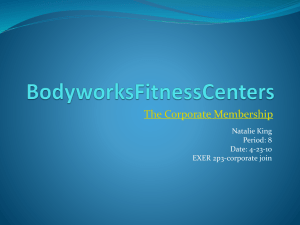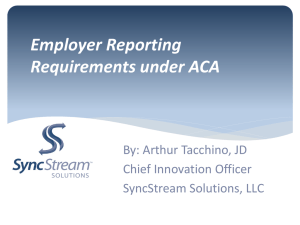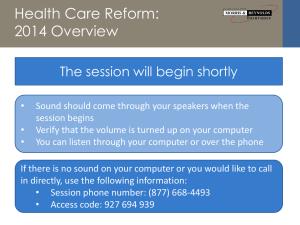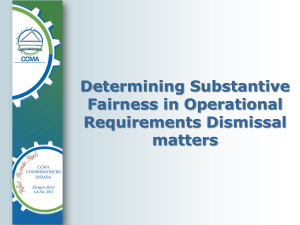Affordable care employer mandate Play-or-Pay Rules
advertisement
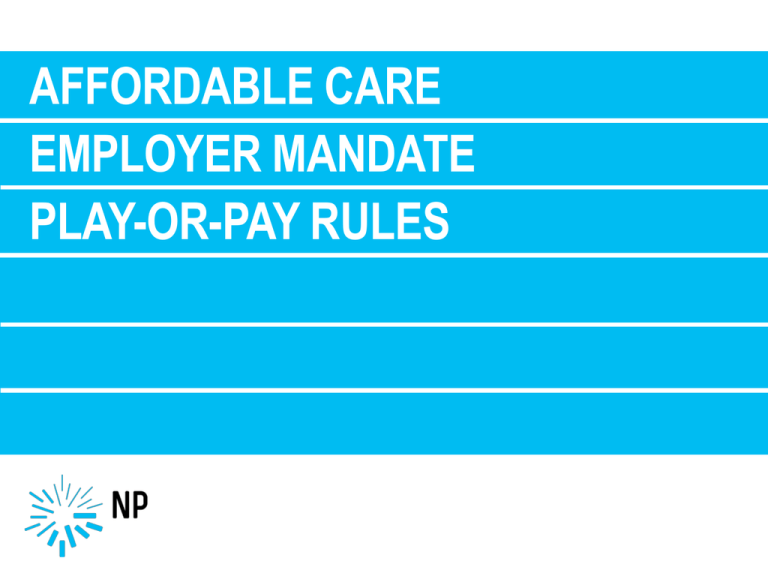
AFFORDABLE CARE EMPLOYER MANDATE PLAY-OR-PAY RULES AGENDA NEW PLAY-OR-PAY RULES UNDER THE AFFORDABLE CARE ACT • “Large Employer” Defined • Effective Date of Mandate • Two Types of Large Employer Penalties • Full-Time Employee Defined • IRS Information Reporting 2 2015 MANDATES “LARGE EMPLOYER” DEFINED 3 WHAT IS A COVERED “LARGE” EMPLOYER? • An employer that had 50+ common law employees, or an equivalent combination of full-time and part time employees (referred to as FULL-TIME EQUIVALENTS), on average during the prior calendar year • Full-time Employees (30 hours/week) • Full-time Equivalents (aggregate PT hours (up to 120 for each part-time employee) each month and divide by 120) • Seasonal workers can be backed out of the equation in some circumstances • if employ 50+ employees for only 120 days/4 months or fewer during the year, and • the only reason the employee count exceeded 50 in those months was due to seasonal employees who worked no more than 120 days/4 months during the year 4 CALCULATING FT EMPLOYEES CALCULATING FT EMPLOYEES TO DETERMINE LARGE EMPLOYER STATUS Step 1 Determine the # of FT Employees (including seasonal) for each calendar month in the preceding plan year Step 2 Determine the # of FTEs (including seasonal) for each calendar month in the preceding calendar year [Aggregate monthly service hours divided by 120] Step 3 Add the FT and the FTE (Steps 1 and 2) for each of the 12 months in the preceding calendar year Step 4 Add the 12 monthly #s from Step 3 and divide the total by 12 Step 5 If the # of FT Employees in Step 4 is less than 50 the group is not considered an applicable large employer for the current calendar year Step 6 If the # of FT Employees in Step 4 is 50 or more, determine whether the ***seasonal employee exception applies: *** Count exceeds 50 FT Employees for 120 fewer days (or 4 months) in a year and employees in excess of 50 employed in that period were seasonal workers -If exception applies, the employer is NOT considered large 5 AGGREGATION RULES LARGE EMPLOYER AGGREGATION RULES • COMMON OWNERSHIP OR CONTROL: • Parent-Subsidiary: Parent Co. owns 80% or more of a subsidiary (or one NFP board controls 80% of other NFP Board) • Brother/sister: Five or fewer shareholders (who are individuals, estates, or trusts) own at least 80% of each corporation and own more than 50% of all corporations taking into account identical ownership interests with respect to each corporation • AFFILIATED SERVICE GROUPS: Aggregate certain service organizations that engage in joint activity, manage each other, or have some overlapping ownership • MANAGEMENT SERVICES: One entity exists to provide management to the other entity • GOVERNMENT AND CHURCH PLANS: “Good faith interpretation” until further guidance is issued 6 AGGREGATION RULES FAMILY MEMBERS • An individual's interest ownership must be attributed to certain family members, which can cause otherwise unrelated businesses held by family members or trusts to be caught up under the rules • With certain limited exceptions, an individual is considered to own any interest owned by the individual's SPOUSE as well as any interest owned by the individual's CHILDREN UNDER AGE 21 • If the individual is in effective control of an organization, then the individual also is considered to own an interest in the organization owned, directly or indirectly, by the individual's parents, grandparents, grandchildren, and children who have attained the age of 21 7 AGGREGATION RULES AGGREGATION RULES AND PENALTIES • Although large employer status is determined on an aggregated basis, the determination of whether an employer is subject to a penalty (and the amount of any such penalty) is determined on a MEMBER-BY-MEMBER BASIS • If an employee is employed by more than one large employer member, an hour of service for one member COUNTS AS AN HOUR OF SERVICE FOR ALL MEMBERS • The employee penalty reduction (80 employees in 2015, 30 for years thereafter) is shared by all of the members of the large employer group • Divided pro rata in proportion to the member’s FTEs 8 2015 MANDATES EFFECTIVE DATE OF MANDATE 9 WHEN IS THE PLAY-OR-PAY MANDATE EFFECTIVE? EFFECTIVE DATE DEPENDS ON SEVERAL FACTORS • EMPLOYER SIZE • Employers with 100+ FTEs: generally January 1, 2015 • Employers with 50-99 FTEs: • Generally January 1, 2016 if employer qualifies for the employer size transition rule • Otherwise generally January 1, 2015 • PLAN YEAR • If the Plan Year of the health insurance plan is not a calendar year, then the effective date may be delayed until the first day of the Plan Year in 2015 or 2016 (as applicable), if the employer qualifies for the fiscal year transition rules 10 WHEN IS THE PLAY-OR-PAY MANDATE EFFECTIVE? EMPLOYER SIZE TRANSITION RULE • If employer has 50-99 FTEs, then the employer will not be treated as a large employer if: • From 2/9/2014 - 2/31/2014, the employer DOES NOT REDUCE THE SIZE OF ITS WORK FORCE or overall hours of service in order to satisfy the size condition (i.e., work force reductions must be for other bona fide business reasons); • The employer DOES NOT CHANGE THE PLAN YEAR date after 2/9/2014; and • The employer does not eliminate or reduce the coverage, if any, it offered as of 2/9/2014, which means: • The employer continues to offer eligible employees an EMPLOYER CONTRIBUTION toward employee-only coverage that is either (a) at least 95% OF THE DOLLAR AMOUNT, or (b) THE SAME OR HIGHER PERCENTAGE of the contribution on 2/9/2014; • If there is a change in benefits, the coverage offers MINIMUM VALUE afterward; and • The employer does not alter its plan to reduce the CLASS OR CLASSES OF EMPLOYEES OR DEPENDENTS to whom coverage was offered on 2/9/2014 11 WHEN IS THE PLAY-OR-PAY MANDATE EFFECTIVE? EMPLOYER SIZE TRANSITION RULE (CONT’D) • Employers will be required to certify that they meet the above requirements as part of the new employer reporting requirement under Code Section 6056 to take advantage of this transition rule • Certification will take place on IRS transmittal report (Form 1094-C) • Reporting begins in early 2016 for 2015 calendar year 12 WHEN IS THE PLAY-OR-PAY MANDATE EFFECTIVE? FISCAL YEAR TRANSITION RULE • Employer maintained a NON-CALENDAR-YEAR PLAN on 12/27/12 • Employer has NOT MOVED THE PLAN YEAR to begin at a later calendar date since that time • With respect to employees who were eligible for coverage under the terms of the plan as it existed on 2/9/14, the employee is offered affordable minimum value coverage no later than the first day of the 2015 plan year; and • As of the first day of the 2015 plan year, Employer offers minimum essential coverage to 70% of its full-time employees 13 WHEN IS THE PLAY-OR-PAY MANDATE EFFECTIVE? FISCAL YEAR TRANSITION RULE (CONT’D) • With respect to employees who were not eligible for coverage under the terms of the plan as it existed on 2/9/14, the employee is offered affordable minimum value coverage no later than the first day of the 2015 plan year, and one of the following is true: • As of any date during the period from 2/10/13 through 2/9/14, at least ¼ of all of the employer’s COMMON LAW EMPLOYEES (full-time, part-time, seasonal, etc.) were ACTUALLY COVERED under the non-calendar-year plan, or • At least 1/3 of all of the employer’s COMMON LAW EMPLOYEES (full-time, part-time, seasonal, etc.) were OFFERED COVERAGE under the non-calendaryear plan during the open enrollment period that ended most recently before 2/9/14, or • As of any date during the period from 2/10/13 through 2/9/14, at least 1/3 of the employer’s FULL-TIME EMPLOYEES (using the new 30-hour definition) were ACTUALLY COVERED under your non-calendar-year plan, or • At least ½ of the employer’s FULL-TIME EMPLOYEES (using the new 30-hour definition) were OFFERED COVERAGE under the non-calendar-year plan during the open enrollment period that ended most recently before 2/9/14 14 HEALTH CARE REFORM TWO TYPES OF LARGE EMPLOYER PENALTIES 15 PENALTY 1: NO EMPLOYER COVERAGE “SLEDGE HAMMER” PENALTY • Effective January 1, 2015, large employers that do not OFFER health coverage to SUBSTANTIALLY ALL of their full-time employees and their DEPENDENTS, and that have at least one full-time employee receiving a subsidy from the federal government, will have to pay an annual tax of $2,000 per each full-time employee • Applies to every full-time employee on the employer’s headcount, including employees not receiving a government subsidy and employees who actually receive employer health insurance • Disregards the first 30 EMPLOYEES • 2015 Transition Rule: If a large employer has 100 or more full-time employees, the first 80 employees are disregarded • “SUBSTANTIALLY ALL”= 95% of, or all but 5, full-time employees • 2015 Transition Rule: 70% of full-time employees for 2015 only 16 PENALTY 1: NO EMPLOYER COVERAGE “SLEDGE HAMMER” PENALTY (CONT’D) • Dependent = Biological and adopted children to age 26 • Prior requirement to cover step and foster children eliminated • Does not require coverage for a spouse • Dependents must be covered UNTIL THE END OF THE MONTH that they turn 26 • 2015 Transition Rule: Employers won’t be penalized if took steps to expand dependent coverage but the coverage was not in place by 2015 (e.g., if requested to add coverage, but carrier did not have in place on time) • Penalty is calculated monthly (i.e., $2,000/12) 17 PENALTY 2: UNAFFORDABLE COVERAGE/ MINIMUM VALUE “TACK HAMMER” PENALTY • The penalty imposed on an employer that offers coverage that is unaffordable or does not satisfy the minimum value rule is a tax of $3,000 per year for each full-time employee who actually receives federal premium assistance for coverage • MINIMUM VALUE STANDARD: The plan must pay at least 60% of the cost for covered benefits under the plan • AFFORDABILITY STANDARD: Employee’s share of the cost for single coverage (for the employer’s least expensive option providing minimum value) cannot exceed 9.5% of the employee’s household income • Capped at $2,000 times the number of the employer’s total full-time employees, but disregarding the first 30 full-time employees (i.e., the value of Penalty 1) • 2015 Transition Rule: If a large employer has 100 or more full-time employees, the first 80 employees are disregarded. • Penalty is calculated monthly (i.e., $3,000/12) 18 AFFORDABILITY OPTIONAL AFFORDABILITY SAFE HARBORS • Regulations provide three “safe-harbors” that can be used as proxies for household income: • the FEDERAL POVERTY LINE for a single individual • the employee’s W-2 wages (Box 1) • the employee’s CURRENT MONTHLY PAY RATE at beginning of plan year (salary if exempt, or hourly rate X 130 hours/mo. if nonexempt) • If HOURLY employee’s salary is reduced, use of lowest rate of pay for that month is now permitted • An employer may use these optional safe harbors for all its employees or any reasonable classification on a uniform and consistent basis • Reasonable classifications include specified job categories, nature of compensation (hourly or salary), geographic location, and similar bona fide business criteria) 19 UNAFFORDABLE COVERAGE 20 AFFORDABLE COVERAGE SAFE HARBOR Rate of Pay Safe Harbor Max EE Contribution (9.5% of Rate of Pay) Pay and Hours Status $20,000 Hourly 40 hours per week $19,400 $9.62 $15,007 $1,843 $1,426 Hourly 30 hours per week $48,500 $32.51 $50,715 $4,608 $4,818 Salaried 40 hours per week $77,600 $38.46 $80,000 $7372 $7,600 $80,000 1 Hourly Wage W-2 Safe Harbor Max EE Contribution (9.5% of W-2 Wages) Annual Gross Wages $50,000 W-2 Wages1 “Rate of Pay” (Hourly Rate X 130 hours/month if hourly, salary if salaried, X12 months) Assume employee puts 2% in 401(k) or 403(b), and 1% in cafeteria plan contributions. MINIMUM VALUE AND AFFORDABILITY IMPACT OF WELLNESS CREDITS • Wellness program financial incentives that affect cost-sharing provisions (deductibles, coinsurance, co-pays, etc.) will count toward the Minimum Value percentage ONLY TO THE EXTENT THE INCENTIVES RELATE TO TOBACCO USE • The Affordability of an employer-sponsored plan will be affected only to the extent the wellness program financial incentive is delivered in the form of a premium subsidy or surcharge RELATED TO TOBACCO USE • Premiums discounts for other wellness incentives are ignored in the affordability calculation 21 OFFERS OF COVERAGE OTHER ENTITIES MAY OFFER COVERAGE ON BEHALF OF EMPLOYER • An offer of coverage includes an offer of coverage made on behalf of an employer, including: • An offer by another member of the same CONTROLLED GROUP • An offer made by a MULTIEMPLOYER or single employer Taft-Hartley plan on behalf of a contributing employer of that employee, but only if the coverage offered is affordable and provides Minimum Value • An offer made by a MEWA to an employee on behalf of a contributing employer of that employee • An offer made by a PEO OR STAFFING FIRM to the client employer’s employees, but only if the fee the client employer would pay to the staffing firm for an employee enrolled in health coverage under the plan is HIGHER than the fee the client employer would pay to the staffing firm for the same employee if the employee did not enroll in health coverage under the plan 22 OFFERS OF COVERAGE OPTION TO DECLINE COVERAGE • Employers must provide employees the option to decline coverage if the coverage: • is not affordable, or • does not offer Minimum Value 23 2015 MANDATES FULL-TIME EMPLOYEE DEFINED 24 WHO NEEDS TO BE OFFERED COVERAGE? • A full-time employee is defined as an employee who averages 30 “hours of service” for the employer per week, or 130 hours of service per month • Count actual hours taking into account hours for all members of the CONTROLLED GROUP • Special exceptions for “bona fide volunteers” (e.g., volunteer firefighters, EMTs) and federal work study programs. • Hours of service include not only hours worked by the employee, but also those hours for which an employee was paid but did not perform work because of: • vacation • layoff • holiday • jury duty • illness • military duty • incapacity (including disability) • leave of absence 25 WHO NEEDS TO BE OFFERED COVERAGE? ESTIMATING HOURS • For employees who are not paid on an hourly basis, employers may count actual hours, or apply an equivalency method of: • 8 hours per day worked; or • 40 hours per week worked; but • only if this method does not substantially understate an employee’s hours of service • Employer may use different methods for different classifications of employees • Employers must use method chosen for a group of employees for the entire calendar year 26 WHO NEEDS TO BE OFFERED COVERAGE? ESTIMATING HOURS (CONT’D) • Pending further guidance, employers must use a reasonable method for estimating hours for employees whose pay is not based on hours worked and whose time is not tracked (e.g., adjuncts, coaches, commissioned salespeople) • A method is not reasonable if it takes into account only a portion of an employee’s hours of service with the effect of characterizing the employee as non-full-time employee if the employee’s position traditionally involves at least 30 hours of service per week • e.g., it is not reasonable to fail to credit travel time for a travelling salesperson compensated on a commission basis 27 WHO NEEDS TO BE OFFERED COVERAGE? SPECIAL RULES FOR ESTIMATING HOURS • ON-CALL HOURS: Must credit an employee with an hour of service for any on-call hour for which payment is made, for which employee must remain on premises, or where employee’s activities are subject to substantial restrictions that prevent the employee from using the time effectively for the employee’s own purposes • AIRLINE INDUSTRY: Special rules for layover hours in the airline industry • ADJUNCT FACULTY: Reasonable method would credit (a) 2 ¼ hours per week for each hour of teaching or classroom time, plus (b) an hour of service per week for each additional hour performing required duties outside the classroom (e.g., office hours, faculty meetings) 28 COUNTING HOURS: MONTHLY MEASUREMENT OR LOOK-BACK TWO OPTIONS FOR MEASURING HOURS • MONTHLY MEASUREMENT METHOD (“GOTCHA” METHOD) • Based on the hours of service for each calendar month, calculated at the end of the month • Month-by-month determinations may work for employers with workforces with stable populations of full-time employees whose hours do not change • LOOK-BACK MEASUREMENT METHOD • Optional safe harbor look-back approach for identifying full-time employees • Average hours during the lookback MEASUREMENT PERIOD, define the employee’s status for a subsequent STABILITY PERIOD 29 MONTHLY MEASUREMENT METHOD OPTIONAL WEEKLY RULE FOR MONTHLY MEASUREMENT METHOD • The regulations allow an employer to determine an employee’s fulltime employee status for a calendar month under the Monthly Measurement Method based on the hours of service over successive one-week periods • Week means any period of 7consecutive calendar days applied consistently for each calendar month of the year • The period measured for the month must contain either the week that includes the first day of the month or the week that includes the last day of the month, but not both • Full-time employee status for certain calendar months is based on hours of service over 4-week periods and for certain other calendar months on hours of service over 5-week periods • 4-WEEK PERIODS: 120 hours = FT • 5-WEEK PERIODS: 150 hours = FT • However, an employer is only treated as having offered coverage for a calendar month if it offers coverage to a full-time employee for the entire calendar month, regardless of this rule 30 LOOK-BACK MEASUREMENT METHOD OPTIONAL PAY PERIOD RULE FOR LOOK-BACK METHOD • For pay periods that are weekly, biweekly, or semi-monthly, the employer may use pay period dates that include the Measurement Period dates in the employer’s policy to mark the start and end of the Measurement Period • e.g. an Employer using the calendar year as a measurement period could exclude the entire payroll period that included January 1 (the beginning of the year) if it included the entire payroll period that included December 31 (the end of that same year), or • e.g., alternatively, the employer could exclude the entire payroll period that included December 31 of a calendar year if it included the entire payroll period that included January 1 of that calendar year 31 LOOK-BACK MEASUREMENT METHOD MEASUREMENT AND STABILITY PERIODS • Different tests apply for: • ONGOING EMPLOYEES: an employee who has been employed for at least one standard measurement period • NEW HIRES: an employee who has not been employed for at least one standard measurement period 32 STANDARD LOOK-BACK PERIODS FOR ONGOING EMPLOYEES Hours are tracked during a Standard Measurement Period and used to determine the employee’s status during the Standard Stability Period • STANDARD MEASUREMENT PERIOD: period designated by the employer that lasts between 6 and 12 calendar months* • STANDARD ADMINISTRATIVE PERIOD: optional period of time after a Standard measurement Period and before the next Standard Stability Period, which cannot exceed 90 days. Each Standard Administrative Period overlaps the prior Standard Stability Period • STANDARD STABILITY PERIOD: period designated by the employer that lasts between 6 and 12 months that begins after, and is no shorter than, the Standard Measurement Period The standard measurement and stability periods must be the same length of time, and at least 6 but no more than 12 months • 2015 Transition Rule: For an initial 12-month Standard Stability Period beginning in 2015, employer may use a one-time shorter measurement period that begins on or before July 1, 2014, lasts at least 6 months, and ends no sooner than 90 days before start of the Standard Stability Period *Although regulations state 3 months, other rules compel minimum of 6 month s 33 HOW STANDARD LOOK-BACK PERIODS WORK 34 ASSUME • Standard Stability Period: Calendar year Year 1 Jan Year 2 Jan Year 3 Jan Standard Stability Period HOW STANDARD LOOK-BACK PERIODS WORK 35 ASSUME • Standard Stability Period: Calendar year • Standard Measurement Period: 12 month period ending October 15 Year 1 Jan Year 2 Jan Year 3 Jan Standard Measurement Period Standard Stability Period HOW STANDARD LOOK-BACK PERIODS WORK 36 ASSUME • Standard Stability Period: Calendar year • Standard Measurement Period: 12 month period ending October 15 • Administrative Period: 77 day period from October 15 through December 31 Year 1 Jan Year 2 Jan Year 3 Jan Standard Measurement Period Admin. Period Standard Stability Period UTILIZING DIFFERENT MEASUREMENT METHODS PERMITTED CATEGORIES Employers can use different measurement methods (Monthly Measurement vs. Look-Back Measurement), and/or different Measurement Periods and Stability Periods under the Look-Back Measurement method, for employees in the following categories: Salaried employees and hourly employees Employees who work in different states Collectively bargained and non-collectively bargained employees Each group of employees covered by a separate collective bargaining agreement • Different employers within a controlled group • • • • 37 NEW FULL-TIME EMPLOYEES RULE FOR NEW FULL-TIME EMPLOYEES (BOTH MEASUREMENT METHODS) • If a new employee is not a seasonal employee and is REASONABLY EXPECTED to be a full-time employee at the date of hire, the employee must be offered coverage by the first day of the fourth month following hire • Coverage may be required sooner under the 90-DAY waiting period regulations • In order to avoid the Tack Hammer penalty for months 1-3, the coverage, when eventually offered, must provide Minimum Value 38 NEW FULL-TIME EMPLOYEES RULE FOR NEW FULL-TIME EMPLOYEES (LOOK-BACK MEASUREMENT METHOD) • Factors to consider when determining whether employee is reasonably expected to be a full-time employee (or whether instead the employee can be subject to an Initial Measurement Period to determine eligibility) include: • whether the employee is replacing an employee who was full-time • the extent to which employees in the same or comparable positions are or are not full-time • Whether the job was advertised or otherwise communicated /documented as requiring on average 30 or more hours of service per week 39 NEW FULL-TIME EMPLOYEES SPECIAL RULES FOR STAFFING FIRMS (LOOK-BACK MEASUREMENT METHOD) • Determination whether a common law employee of a temporary staffing firm is a variable hour employee is based on the staffing firm’s reasonable expectations at the start date • There are additional factors to consider when determining whether a new employee of a staffing firm intended to be placed on temporary assignments at client organizations is a Variable Hour Employee, including whether employees in the same position with the temporary staffing firm typically: • retain as part of their continuing employment the right to reject temporary placement that the employer staffing firm offers the employee • have periods during which no offer of temporary placement is made • are offered temporary placements for differing periods of time • are offered temporary placements that do not extend beyond 13 weeks 40 LOOK-BACK MEASUREMENT PERIOD: NEW EMPLOYEES RULE FOR NEW EMPLOYEES • If a new employee is a PART-TIME, VARIABLE or SEASONAL employee , the employer may use an Initial Measurement Period up to 12 months to determine full-time status before offering coverage: • PART-TIME: a new employee who is reasonably expected at the employee’s start date not to be a full-time employee (and who is not a variable hour employee or a seasonal employee) • VARIABLE: Employee who, on his start date, the employer cannot determine whether the employee is reasonably expected to average at least 30 hours of service/week • SEASONAL: by the nature of the position an employee in this position typically works for a period of six months or less, and that period should begin each calendar year in APPROXIMATELY THE SAME PART OF THE YEAR, such as summer or winter • In certain unusual instances, the employee can still be considered a seasonal employee even if the seasonal employment is extended in a particular year beyond its customary duration 41 NEW VARIABLE-HOUR, PART-TIME AND SEASONAL EMPLOYEES INITIAL MEASUREMENT PERIOD: 6-12 month period that begins at the date of hire or by the later of the first of the month following hire or first day of first payroll that starts after employee’s start date * INITIAL STABILITY PERIOD: must begin by the first day of the second month following the employee’s first anniversary of employment and must be the same duration as the Standard Stability Period • If the Employee is full-time, the Initial Stability Period must be at least 6 months and no shorter than initial measurement period • If the Employee is not full-time, the Initial Stability Period can only be one month longer than the Initial Measurement Period and must end by the employee’s first Standard Stability Period • Stability Period must be based on calendar months INITIAL ADMINISTRATIVE PERIOD: Period of up to 90 days after the Initial Measurement Period and before the start of the Initial Stability Period • The period between hire and the Initial Measurement Period counts toward 90 day limit *Although regulations state 3 months, other rules compel minimum of 6 month s 42 HOW INITIAL LOOK-BACK PERIODS WORK 43 ASSUME • Calendar Year Standard Stability Period, 12 Month Standard Measurement Period ending 10/15, Admin. Period 10/15-12/31 Year 1 Jan Year 2 Year 3 Jan Jan First Standard Measurement Period Admin. Period First Standard Stability Period HOW INITIAL LOOK-BACK PERIODS WORK 44 ASSUME • Calendar Year Standard Stability Period, 12 Month Standard Measurement Period ending 10/15, Admin. Period 10/15-12/31 • Hire Date of June 15th • 12 month Initial Measurement Period begins first of the month following hire • 1 month Initial Administrative Period Year 1 Jan Year 2 Year 3 Jan Jan Initial Measurement Period Initial Admin. Period First Standard Measurement Period Admin. Period First Standard Stability Period HOW INITIAL LOOK-BACK PERIODS WORK 45 ASSUME • Calendar Year Standard Stability Period, 12 Month Standard Measurement Period ending 10/15, Admin. Period 10/15-12/31 • Hire Date of June 15th • 12 month Initial Measurement Period begins first of the month following hire • 1 month Initial Administrative Period Year 1 Jan Year 2 Year 3 Jan Jan Initial Measurement Period Initial Admin. Period Initial Stability Period if FT First Standard Measurement Period Admin. Period First Standard Stability Period HOW INITIAL LOOK-BACK PERIODS WORK 46 ASSUME • Calendar Year Standard Stability Period, 12 Month Standard Measurement Period ending 10/15, Admin. Period 10/15-12/31 • Hire Date of June 15th • 12 month Initial Measurement Period begins first of the month following hire • 1 month Initial Administrative Period Year 1 Jan Year 2 Year 3 Jan Jan Initial Measurement Period Initial Admin. Period Initial Stability Period if FT Initial Stability Period if NOT FT First Standard Measurement Period Admin. Period First Standard Stability Period SPECIAL RULES FOR INITIAL LOOK-BACK MEASUREMENT PERIOD 47 TRANSFER TO FULL-TIME POSITION Seasonal, Part-Time or Variable employees who transfer to Full-Time positions must be offered coverage by: • the first day of the fourth month following the change in employment status, or • if earlier, the first day of the first month following the end of initial measurement period (plus any applicable administrative period) if the employee averages 30 hours of service per week or more during the initial measurement period SPECIAL RULES FOR INITIAL LOOK-BACK MEASUREMENT PERIOD 48 CHANGE FROM FULL-TIME TO PART-TIME If an employee changes from full-time status to part-time status during the initial measurement period, the employer can use the Monthly Measurement Method for the employee within three months of the change if: • the employee actually averages less than 30 hours of service per week for each of the three full months following the change, and • if the employer has offered the employee continuous coverage that provides Minimum Value from at least the fourth month of the employee’s employment STATUTORY LEAVES OF ABSENCE AND EMPLOYMENT BREAKS CREDITING SERVICE FOR EMPLOYMENT BREAKS UNDER LOOK-BACK MEASUREMENT METHOD • When computing average hours during a Measurement Period, an employer must either: • Exclude any periods of unpaid Family and Medical Leave (FMLA) or military leave under the Uniformed Services Employment and Reemployment Rights Act (USERRA), or JURY DUTY from the equation, or • Credit the employee with hours of service for such leave periods at a rate equal to the employee’s average weekly hours of service during the weeks in the Measurement Period that are not part of the unpaid leave period • EDUCATIONAL INSTITUTIONS must apply the same rules to credit service during non-working school break periods under the academic calendar that exceed 4 consecutive weeks • Need not credit more than 501 hours of service per calendar year due to school break periods 49 BREAKS IN SERVICE REHIRED EMPLOYEES • An employee who terminates employment and is rehired is not treated as a new employee unless: • the employee has been separated for 13 weeks (26 weeks for educational institutions), or • for a period of at least four weeks that is longer than their prior period of employment • This rule does not apply to absences that are unpaid leave under the FMLA, USERRA or Jury Duty • If the rehired employee is not treated as a new employee, he must be offered coverage effective by the first day of the calendar month following the date of rehire 50 TERMINATION OF COVERAGE NONPAYMENT OR LATE PAYMENT OF PREMIUMS • An employer will not be subject to a penalty for failing to offer coverage to an employee for a month if the employee’s coverage is terminated due to the nonpayment or late payment of premiums • This exemption may continue through the end of the coverage period (typically the plan year) in which the termination of coverage occurred • However, an employer is not permitted to terminate coverage for such reasons unless it has complied with COBRA type procedures that include a 30-day payment grace period, provisions for timely payments that are not significantly less than the amount due, and certain notices 51 HOW EMPLOYERS MIGHT RESPOND • Include high deductible plan as an option with or without an HRA (or $500 employer FSA) contribution • Offset costs with large employee contributions for dependent coverage and reduce or restrict coverage to spouses • Use salary-based contribution schedules or subsidize lower income workers • Isolate uncovered full-time employees in a separate entity • Some employers may want to increase their use of part-time employees, use leased employees, or increase use of independent contractors, but strict common law employee tests, worker misclassification liability, anti-abuse rules and bad PR should limit the viability of these types of responses 52 2015 MANDATES IRS INFORMATION REPORTING 53 NEW INFORMATIONAL REPORTING REPORTING REQUIREMENTS • Large Employers must report to the IRS whether they offer their full-time employees and their dependents the opportunity to enroll in health coverage and provide certain other information • Other entities providing Minimum Essential Coverage to employees must report information about the individuals covered. • The IRS will use the information reported to verify employersponsored coverage (for Exchange subsidy eligibility) and to administer the play-or-pay employer penalty provisions • Reporting requirements apply to coverage provided on or after January 1, 2015, with the first information returns filed in 2016 • Employers will report on forms 1094-C (transmittal) and 1095-C (employee return); other reporting entities will use forms 1094-B (transmittal) and 1095-B (employee statement) 54 NEW INFORMATIONAL REPORTING FORMS 1094-B and C and 1095-B and C • The returns will be filed using the same deadlines and procedures as apply to W-2 reporting • Employee returns due January 31 • Government return due on or before February 28 each year (March 31 if filed electronically) • Employers filing 250 or more returns must file electronically • Employee returns can be delivered electronically only if comply with same consent process used for W-2 delivery • Same penalties apply as for incorrect or late W-2s 55 NEW CODE SECTION 6056 REPORTING CODE SECTION 6056 • The employer's return must contain the following information: • the employer's name, address, and EIN • the name and telephone number of the employer’s contact person • whether the employer is a member of a controlled group and information about the other group members • whether the employer is relying on transition relief for delayed compliance (for 50-99 employees or non-calendar year plans) • whether the employer is using a reporting safe harbor (i.e., the Qualifying Offer method or the 98% Offer method) • a certification of whether the employer offers its full-time employees and their dependents the opportunity to enroll in Minimum Essential Coverage, by calendar month • the number of full-time employees the employer has for each calendar month during the calendar year 56 NEW CODE SECTION 6056 REPORTING CODE SECTION 6056 • Employers that offer the opportunity to enroll in health coverage must also report: • the name, address, and SSN of each full-time employee during the calendar year • the months during the calendar year for which Minimum Essential Coverage under the plan was available to the employee • Indicator codes will be used to reflect whether offered coverage provided minimum value, whether it was affordable, to which family members it was offered, whether coverage was offered to a part-time employee, and whether no coverage was offered to the employee • the employee’s share of the monthly premium for the lowest cost option providing Minimum Value for self-only coverage • if the employer is a governmental employer, the name, address and identification number if its designated reporting agent (if applicable) • if a third party is reporting for an employer with respect to its full-time employees, the name, address and identification number of the third party 57 NEW CODE SECTION 6056 REPORTING CODE SECTION 6056 • Indicator codes will be used to reflect the months during which: • the employee was not employed • the employee was not full-time • the employee was actually enrolled in coverage • the employee was in an initial measurement period • the employee was in a limited non-assessment period (e.g., a health plan waiting period, the initial three months of employment if the employee was offered coverage by the 4th month, an initial measurement period, etc.) • the employee was covered by a multiemployer plan • Indicator codes will also be used to reflect which affordability safe harbor applies, if any and whether non-calendar year transition relief applies. 58 NEW CODE SECTION 6055 REPORTING CODE SECTION 6055 • Code Section 6055 requires entities that provide health coverage to an individual during a calendar year to report certain information to the IRS. Reporting entities include: • For insured plans and SHOP Exchange, the insurer • For individual plans purchased on an Exchange, the Exchange • For government-sponsored programs (e.g., Medicare, Medicaid, CHIP, TRICARE), the responsible government department • For self-insured plans, the plan sponsor • For single employer plans, the employer • For a controlled group of corporations, each member must separately report for its own employees • For multiemployer plans, the trustees • Government employers may delegate reporting to another government agency 59 NEW CODE SECTION 6055 REPORTING CODE SECTION 6055 • Reporting only required for plans that provide Minimum Essential Coverage • Does not apply to supplemental plans with the same plan sponsor (e.g., HRAs) or to excepted benefits (e.g., FSAs, dental plans, vision plans, or EAPs) • A return must contain the following information: • the name, address and EIN of the (1) reporting entity, (2) employer sponsoring the coverage, and (3) the coverage provider (e.g., insurer, government, employer with a self-funded plan) • The SHOP marketplace identification number (if applicable) • the name, address, and SSN of the primary insured (i.e., the employee) • the name and SSN of covered dependents (provide DOB if SSN unavailable) • Reporting entity must follow up annually to request SSN if unavailable • the origin of the coverage (e.g., employer, SHOP, government, multiemployer plan, individual policy) • the months during which the individual was covered for at least one day 60 NEW CODE SECTION 6055 REPORTING ALTERNATIVE REPORTING METHODS • Reporting based on certification of qualifying offers • Simplified reporting for employers who (1) offered affordable, Minimum Value coverage to employees in accordance with the FPL affordability safe harbor, and (2) offered coverage to the employees’ spouses and dependents • These employers must provide the employee’s name, SSN, address, and use an indicator code to show a qualifying offer was made for all 12 months • Employers who offered such coverage to 95% of their employees may use a simplified statement for 2015 only 61 NEW CODE SECTION 6055 REPORTING ALTERNATIVE REPORTING METHODS • Option to report without separate identification of full-time employees if certain conditions related to offers of coverage are satisfied (98% RULE) • Simplified reporting for employers who offered affordable, Minimum Value coverage to employees in accordance with any FPL affordability safe harbor • These employers do not need to report the total number of fulltime employees for the year or whether any particular employee was full-time each month • Employers may utilize different alternatives for different groups of employees 62

